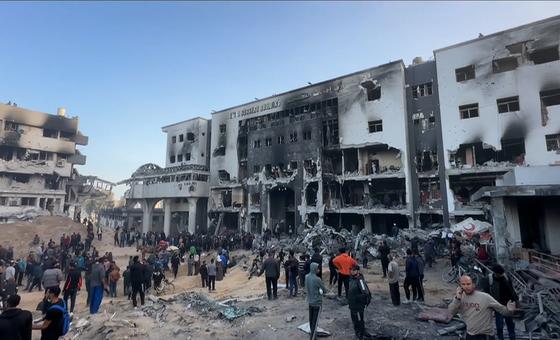In a stark assessment of the closure of 750-bed facility Al-Shifa hospital in Gaza City, the World Health Organization (WHO) maintained that aid teams had been waiting for “days and days” for Israeli permission to reach the stricken facility, where staff and patients endured “horrific levels of violence”.
“We’ve had contact with the staff, the (hospital) directors told us that Al-Shifa has gone, it’s no longer able to function in any way, shape or form” as a medical centre, said WHO spokesperson Dr Margaret Harris.
Reduced to rubble
Speaking to journalists in Geneva, Dr Harris said that the facility was now “in ruins” and that at least 21 patients had died during the Israeli Defense Forces “siege”.
As the situation deteriorated at Al-Shifa, medical staff had to move patients to an office space within the hospital grounds without toilets and where there was “no water (or), food; they were sharing one bottle of water between 15 people by the end”, the WHO spokesperson continued.
She noted that medical staff “had no means of looking after patients, many of whom were severely injured (or) intensive care-level patients” fitted with urinary catheters but lacking urinary bags. “You can imagine the horror that has been going on,” Dr Harris said.
If permission is granted on Tuesday to reach Al-Shifa and northern Gaza’s last few remaining health facilities, priorities for WHO teams include bringing medicines, fuel and food – and assessing what other supplies are needed and how to provide relief to the most severely injured and sick.
Access denied
“We’ve been trying to go for days and days and days and most of our missions have been rejected,” Dr Harris said. “We’re not going to be able to provide the things that, say, a functioning hospital needs, but first of all we need to do an assessment to understand what we can do. Secondly…who needs to be evacuated…where can they go and what can we do to save the lives of those patients (who are) remaining.”
The development comes amid renewed safety concerns for aid operations in Gaza after World Central Kitchen reported that an Israeli airstrike on one of its vehicles had killed seven aid workers in Deir al-Balah, central Gaza. Following those reports and images of the NGO vehicle showing a large hole in its roof, UN Emergency Relief Coordinator Martin Griffiths expressed his outrage at the attack and described the victims are “heroes, killed while trying to feed starving people”.
Echoing that message, WHO’s Dr Harris maintained that the NGO mission had been agreed with the Israeli authorities ahead of time and that the organization’s car was “well marked, it was very clear: it was World Central Kitchen”.
To date, hundreds of healthcare workers have been killed “doing their job”, the WHO official noted, along with 32,000 of civilians, 70 per cent of whom are women and children, amid constant Israeli bombardment launched after Hamas-led terror attacks on Israel on 7 October that left some 1,200 dead and more than 350 taken hostage.
“We are struggling to understand the mortality numbers beyond the numbers that are reported of people who are killed in the bombardment because many people don’t even get to hospital,” the WHO spokesperson said.
Too small to survive
A UN health agency team also intends to visit Kamal Adwan Hospital in Gaza City where there are already dire concerns about the growing number of babies being born too underweight to survive.
The facility is already admitting at least 15 malnourished children per day and the needs are “getting ever more severe”, Dr Harris insisted, in a renewed call for a ceasefire. “It’s got to be taken seriously – the ceasefire, the UN resolution – the world has agreed a ceasefire must happen. It should have happened months ago, but it must happen now.”
Help for the most dangerously malnourished youngsters who are at the “highest risk of imminent death if not urgently treated” is available two WHO-partnered specialized nutrition centres in Rafah and another in Kamal Adwan.
Before conflict erupted, Gazans were self-sufficient in food production and only 0.8 per cent of children under the age of five were acutely malnourished. In the northern governorates today that figure is between 12.4 and 16.5 per cent, the WHO reported.
“Different doctors particularly in the maternity hospitals are reporting that they’re seeing a big rise in children born low birth weight and just not surviving the neo-natal period because they are, they’re born too small,” Dr Harris said.

